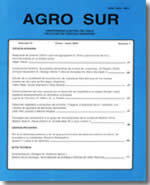USO DE ESPECIES SILVESTRES Y CULTIVADAS EN EL MEJORAMIENTO DE LA PAPA
Contenido principal del artículo
Resumen
Aún cuando el género Solanum ofrece una gran riqueza fitogenética, distribuida en más de 10.000 km de norte a sur por toda la América Morena, el material usado en mejoramiento de la especie a nivel mundial ha sido escaso, lo que ha sido indicado por innumerables mejoradores, que señalan que el “pool” genético básico se ha reutilizado intensamente.
Desde la introducción de la papa a Europa (alrededor de 1550) todas las variedades generadas por más de 250 años parecen haberse derivado de dos introducciones. Sin embargo, por causa de la gran epidemia de Phythopthora infestans, que pudrió las producciones de papa de toda Europa, ocurrida entre 1846 – 1850, diversos investigadores europeos buscaron el centro de origen de esta especie para llevar “nueva sangre” a las alicaídas variedades europeas, y de esta manera ampliar esta base genética.
Múltiples colectas, evaluaciones, uso de nuevas metodologías de mejoramiento han permitido hacer uso de especies silvestres y algunas cultivadas, y conseguir que hoy en día se cuente con un Catálogo Mundial de más de 4.200 cultivares, además de las más de 5.000 variedades nativas que se tienen en los países latinoamericanos.
Nuevos desafíos, que ayuden a producciones en condiciones subóptimas o bien con menores usos de agua y agroquímicos permitirá dar solución a una población mundial con problemas productivos. Por otro lado el calentamiento global, la escasez de la energía y el alto precio de los fertilizantes deben estar en la mira del mejoramiento futuro, como también generar alimentos saludables.
La inmensa riqueza evaluada que hoy cuentan bancos genéticos, permitirá dar respuesta a estos múltiples desafíos a través del mejoramiento convencional y no convencional.

